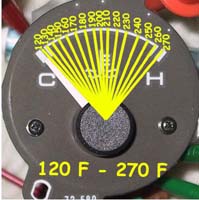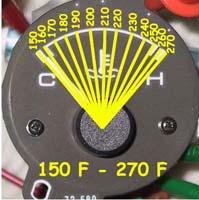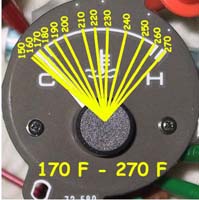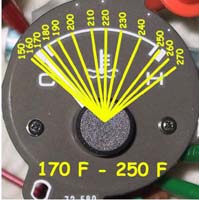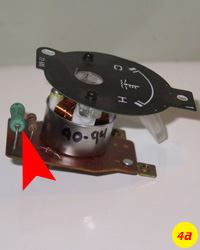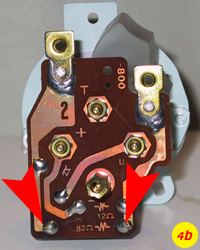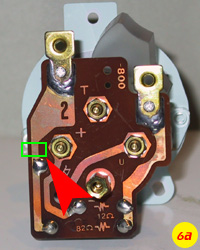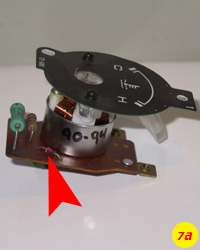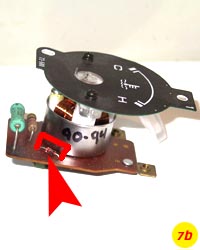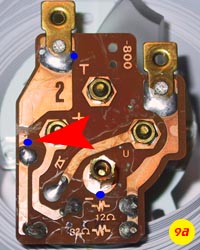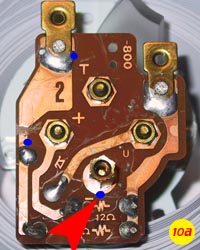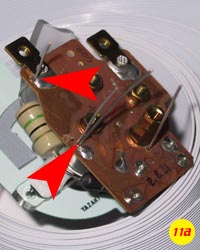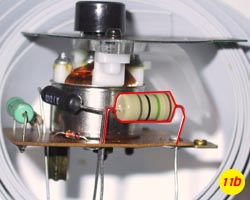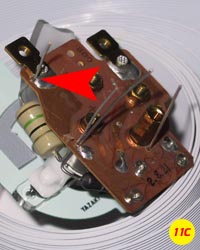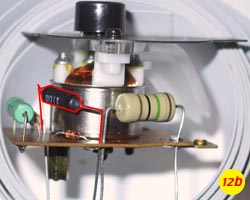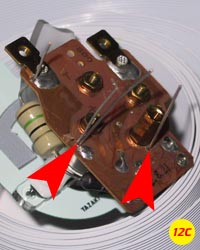- Remove Cluster (1997 Shown, 90-93 Similar)
- Remove 2 screws on Kick Panel below the steering column
- (see picture 1a) - Remove the 4 screws
that hold the steering column/lock cylinder cover in place
- Remove the 2 screws in the bottom of the cluster shroud
- (see picture 1b) - Remove the 4 screws
that hold the cluster in
- (see picture 1c) - Unhook the 2 large
wiring harnesses on the back of the cluster
- Unhook small wiring harness on the back of the cluster (For the
rear defroster indicator light, left hand side of cluster as normally
look at it)
- (see picture 1c) - Unhook the
speedometer cable (push down on the raised bar on the top of the
connector while pulling out gently on the cluster)
- Take the cluster to the workbench
|
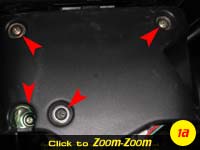

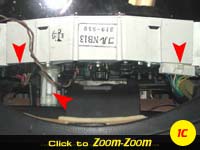 |
- Disassemble the Cluster
- CAUTION - Do not touch the gauge faces, fingerprint oils will not
come off! (I've do it and cleaned them with water,b ut the color of
the face looks different afterwards)
- CAUTION - Do not remove the needles, or bump them. You don't need
to mess with the needles at all for this modification.
- CAUTION - Don't let anything get inside the clear plastic cover
once it is removed. Don't touch the inside of it. Don't scratch it!
- Remove the clear plastic cover
- (see picture 2a) - Press in the black
tabs while gently pulling out on the clear assembly. Start at one
end, applying pressure while pushing them in, and it should work
fine.
- If you are having trouble with it clicking itself back together
as you go around, stick a small screwdriver in between the cluster
and the clear piece as you work your way around, careful not to hit
the faces/needles.
- (see picture 2b) - Make sure the rear
defroster indicator light wiring harness comes out through the hole
in the casing, you will probably have to pull the circuit trace part
back a little to feed it through the hole. Bending it won't hurt the
traces, so move it as needed. Make a note of how it was routed so it
is reassembled the same.
|
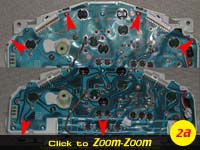
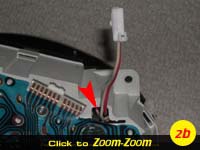 |
- Remove the Temperature Gauge Assembly
- (see picture 3a) - Remove the 3 screws
on the back side that are holding the gauge in. The gauge may fall
out, so be mindful of it coming loose.
- Pull gauge out the front of the cluster, set cluster aside (make
sure the faces don't get touched!)
|
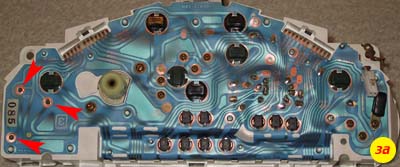 |
- Modify the Temperature Gauge
- (see picture 4a) - Remove the 82 ohm
resistor
- (see picture 4b) - Heat the solder on
the back
- Suck/wick hot solder away
- Bend legs over on resistor so it will pull out
- Pull out resistor from front side
|
|
- Install the 82 ohm, 5 watt resistor
- Bend legs over on the new resitor
- Insert legs into holes from the top side. Make sure to leave it up
off the board so it isn't touching anything and air can get around it
on all sides.
- Bend over ends of tails on back side
- Solder points on the board on the back side
- Nip off the tails of the wires you just soldered
- Bend the resistor as needed to maintain air gap on all sides.
|
NEW IMAGE, NEW IMAGE |
- Cut Temp Sender Trace
- (see picture 6a) - Using a sharp object
(knife, pointy screwdriver), scrape the trace off the back of the
gauge, removing the copper material
|
|
- (see picture 7a) - Short out the Zener
Diode
- (see picture 7b) - Soldier a small
jumper across both ends of the zener diode
|
|
- (see picture 8a) - Using the drill and a
very small bit, drill a hole in the temp sender trace near the mounting
screw
|
|
- (see picture 9a) - Drill small hole in the
temp sender trace on the other side of the break you created in step 6a
|
|
- (see picture 10a) - Drill a small hole in
the ground trace, next to the mounting screw
|
|
- (see picture 11a and 11b) - Install the
Series resistor in the temp sender trace holes
- Bend legs over
- Insert in holes (one end in the mounting screw hole you drilled,
the other in the other temp sender hole you drilled.
- Bend over ends, making sure it is sitting high up off the board
and not touching anything.
- (see picture 11c) - Solder the mount
screw end
- Nip off all tail from end you just soldered
|
|
- (see picture 12a and 12b) - Install the
parallel resistor between ground and temp
sender trace
- Bend legs over
- Insert in holes (one end in the lower trace hole you drilled, the
other in the ground trace hole you drilled.
- Bend over ends, making sure it is sitting high up off the board
and not touching anything.
- (see picture 12c) - Solder both ends
- Nip off all tails from ends you just soldered
|
|
- Reassemble the Cluster
- Put gauge back in, aligning posts with holes in gauge face
- Verify that the large 82 ohm resistor isn't touching anything in
the cluster
- (see picture 3a) - Put in the 3 screws
on the back
- (see picture 2a) - Put the clear plastic
cover back on, snapping it in place all the way around.
- (see picture 2b) - Make sure to feed the
wiring harness into the hole in the casing, and route it as it was
before.
|
see picture 3a above
see picture 2a above
see picture 2b above |
- Calibrate/Reference the Gauge
- You have to disconnect the temperature sender from the head in
order to properly check the connections... either that or you need to
connect the gauge to power and ground while outside of the cluster.
Either way is a pain. I use a power supply on my workbench so it's
easy. :) If you disconnect the sender from the head, then this is the
way to calibrate:
- (see picture 13a) - Install "COLD"
calibration resistor from the temp sender wire (farthest right when
connected, Blue w/ blue strip on my 97) on the right hand harness to a
ground point on the chassis.
- Turn car on (do not start)
- Gauge should read "C" (the first mark on the left)
- If it reads nothing:
Check that your calibration resistor assembly is touching both
ends.
If it still isn't reading, tear it apart and double check your
connections starting at step 7a looking for anything that is
loose.
- If it reads pegged to the right:
Remove Calibration resistor, if still pegged, tear it apart
and double check your connections starting at step 7a
- If it reads a long way off:
Did you use the right size resistors?
- If it reads "C", then you have made the right connections. The
worst that can happen now is that the scale may be off.
- Switch "COLD" calibration resistor to "HOT" calibration resistor.
- Gauge should read "H" (the last mark on the right)
- If it reads nothing:
Check that your calibration resistor assembly is touching both
ends.
- If it reads a long way off:
Did you use the right size resistors?
- If it reads "H", then you did it all right!
- Remove calibration resistor
- Reconnect temp sender wire at the head
|
new image
new image
|
- Reinstall the cluster in the car
- Insert Cluster into opening, aligning the speedometer cable
assembly.
- (see picture 1c) - Click speedometer
cable onto cluster
- (see picture 1c) - Connect 3 wiring
harnesses on the back of the cluster
- (see picture 1b) - Install 4 screws
holding the cluster in
- Snap shroud back on over cluster. Make sure to put it in straight
so as to not snap off the guide pins.
- Install 2 screws in bottom of shroud
- Reassemble the column/lock cylinder cover pieces
- (see picture 1a) - Install 4 screws
holding cover in place
- Install kick panel and 2 screws
|
see picture 1c above
see picture 1b above
see picture 1c above |
- Test Gauge
- Turn ignition to "on", the gauge may move a very small amount
(maybe 1/16" of an inch, it shouldn't rise above "C")
- Drive car until it warms up to normal operating temperature. The
needle should indicate roughly 190 degrees (per the image above).
|
|


